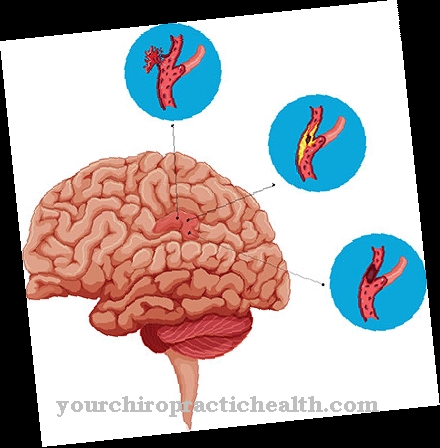Xanthelasma are harmless, but they can still be difficult for those affected. The deposits under the skin are usually in a clearly visible place and are therefore an aesthetic problem. People who notice xanthelasma on their skin should definitely see their doctor right away.
What is a Xanthelasma?
Xanthelasma are yellowish, sometimes reddish, fatty nodules in the skin of the eyelids. They appear symmetrically at the inner angle of the upper and lower eyelids. In most cases, the upper eyelids are affected. The sharply outlined fat deposits are mostly soft (foam cells), consist mainly of cholesterol and can be moved with a little pressure. The skin above allows the lipid deposits to show through.
Although they are not contagious and will cause no further problems for those who wear them, most people have them surgically removed. The unsightly fat nodules are caused by a disorder of fat metabolism, which can be congenital or acquired. It usually only occurs from the age of 40. Women are more often affected than men.
causes
When xanthelasma develops, the excess fat (mostly cholesterol) is stored in the form of foam cells under the surface of the skin. The cells are actually macrophages (scavenger cells) of the immune system. In patients with xanthelasma, the attending physician usually also finds an increased cholesterol level, diabetes mellitus, alcohol-related cirrhosis of the liver or inflammation of the pancreas (hyperlipidemic xanthelasma).
However, people without abnormally elevated blood lipid levels can also suffer from xanthelasma (normolipidemic xanthelasma). Whether the tendency to xanthelasma can be inherited has not yet been conclusively clarified. Patients with xanthelasma who do not have too high a cholesterol level are nevertheless classified as a risk group by medical research: You are more at risk of developing cardiovascular disease than people without the unsightly subcutaneous fat nodules. You suffer 50 percent more heart attacks than other people. Research also assumes that they have an increased tendency to store cholesterol in the walls of the blood vessels (arteriosclerosis). They may also have primary biliary cirrhosis of the liver.
Symptoms, ailments & signs
Xanthelasma are painless and are not associated with any other symptoms. Therefore, they are also seen as a purely cosmetic problem: the costs of removing them are only covered by private health insurances. The fat deposits that those affected find emotionally stressful sometimes even appear within a short time (eruptive xanthelasma).
Occasionally, the person affected will find them in other parts of their body (tendon sheaths and extensor sides of the elbows, knee joints, buttocks). There they are called xanthomas.
Diagnosis & course of disease
Patients with xanthelasma should first have their blood values checked to find out whether their fat deposits are caused by a lipid metabolism disorder. The doctor determines cholesterol, blood sugar, thyroid and uric acid levels. If the result is positive, the underlying disease is treated.
Despite therapy, the unsightly fat blisters usually do not recede on their own. Over time, more and more xanthelasma can form on the eyelids. In addition, existing ones can be made taller and wider. In rare cases, they can cause permanent drooping of the eyelid (ptosis).
Complications
Xanthelasma are usually not associated with complications. For many sufferers, however, they represent a cosmetic problem that needs to be treated. If there is no treatment, for example because the health insurance company does not cover the costs, this often results in emotional complaints for the person concerned.
Social anxiety and depression can develop - problems that permanently limit well-being and quality of life. Serious psychological complaints are particularly possible with a spontaneous new formation or a spread of fat deposits to other parts of the body. Physical discomfort can occur if the person concerned scratches the xanthelasma or handles it improperly.
Certain cosmetics can cause skin irritation and, under certain circumstances, also affect the fat deposits. There is always a risk of scars and adhesions during surgical treatment. Bleeding and wound healing disorders can also occur. The application of trichloroacetic acid can also leave scars.
If the xanthelasma is in the eye area, ectropion can occur. Laser treatment can leave scars and lead to burns. Sensory disturbances can also occur in the affected area. Allergic reactions are also possible, depending on the type of treatment.
When should you go to the doctor?
If the skin's appearance changes, a doctor should check the optical irregularities. If they occur suddenly and suddenly, they are often an indication of a health impairment. Since there are risks of complications, a doctor should be consulted if the symptoms increase or if discrepancies persist. Although the Xanthelasma show no disease value from a medical point of view, other skin diseases should be excluded. This is only possible if the person concerned seeks cooperation with a doctor to clarify the cause. If nodules form or discoloration of the skin appears, this is in many cases to be understood as a warning signal from the organism.
Often there are changes in the eyelid area. This can be uncomfortable and lead to a visual flaw. Consultation with a doctor is advisable if changes in the complexion of the skin lead to mental or emotional distress. If there are strong feelings of shame or if there is a withdrawal from social life, a doctor's visit is necessary. The person concerned needs help with fears, a decline in cognitive performance or a depressed mood. If vegetative disorders, an inner restlessness or if there is never-ending brooding, a visit to the doctor is recommended.
Therapy & Treatment
Since the xanthelasma usually does not go away even after the treatment of the underlying disease, surgical removal is recommended. Depending on the location and size of the nodules, they are removed with the help of electrocautery, cryosurgery, laser technology, surgical excision and the application of trichloroacetic acid.
The disadvantage of excision is that it usually leaves scars and the surgical site is reddened for a long time. Since the annoying fat nodules usually reappear later in the same place, the surgical procedure usually only makes sense if the patient has an upper eyelid tightened at the same time. The most frequently used and most successful method is lasering the xanthelasma.
Erbium lasers, CO2, dye and argon lasers are used. They don't leave any visible scars. The lasered area of the skin is usually healed after a few days. After the second treatment at the latest, the xanthelasma will have finally disappeared and will not reappear. The only disadvantage of laser treatment is that some patients can develop hypo- and hyper-pigmentation at the treated area.
Applying 50 percent trichloroacetic acid has the disadvantage that it also leaves scars. In rare cases, an ectropion can occur (the edge of the eyelid is bent outwards).If there is not enough skin at the xanthelasma site, normal surgical intervention can result in the eyelid no longer closing. In addition, (visible) scar shrinkage can occur.
You can find your medication here
➔ Medicines against redness and eczemaprevention
The patient cannot prevent the appearance of xanthelasma because the exact factors that lead to it have not yet been fully clarified by medical research. However, regular blood tests can provide an initial indication of a possible blood lipid disorder. If the result is positive, it is advisable to change your diet to a low-fat diet with a high content of omega-3 fatty acids and omega-6 fatty acids. Lipid lowering agents also ensure normal blood fat levels.
A weight loss diet can also help to better regulate the lipid balance. With a healthier lifestyle, the patient can at least reduce the risk of developing xanthelasma somewhat. Instead of lipid-lowering drugs, he can also take Allium sativum in potencies D2 to D6 (10 of the D6 drops twice a day). Artichoke extract and pressed artichoke juice also help lower cholesterol levels.
Aftercare
Skin abnormalities such as xanthelasma can be surgically removed without any problems. A local anesthetic ensures that the patients enjoy a largely painless treatment. The procedure takes about 15 to 20 minutes. Afterwards, those affected can immediately go about their normal activities.
However, it is important to avoid prolonged exposure to heat such as a sauna or solarium for at least six weeks after the treatment. Long and prolonged exposure to the sun should also be avoided. For the aftercare of xanthelasma, the doctor prescribes an antibiotic ointment. Wound healing is possible without a suture.
An appointment to pull the strings is therefore not necessary. Patients are able to work and socialize again just one or two days after treatment. Since the risk of relapse is extremely high, a healthy diet is part of the aftercare. It is advisable to switch to a diet rich in vegetables, fruits and fiber. In addition, it is advisable to give up smoking.
Nicotine increases the risk of getting xanthelasma again. As a rule, the attending physicians advise in advance what needs to be observed during follow-up care and what it will look like. Since there are different ways to remove a xanthelasma, the type of aftercare also changes accordingly.
You can do that yourself
The Xanthelasma lead to aesthetic irregularities and thus to an emotional challenge for those affected. A stable and healthy self-confidence is helpful in everyday life. This protects against phases of extreme well-being and can be an important pillar in coping with the disease.
The symptoms improve when the body's own weight is in the normal range of the BMI. Obesity and a fatty or excessively sweet diet should therefore be avoided. At the same time, sufficient exercise should take place, as this stimulates the metabolism and helps to reduce excess weight. Emotional as well as physical stressors lead to a worsening of the overall situation, since they represent an additional burden for the entire organism. Therefore, everyday life should be checked for existing stress triggers and, if possible, persistent and negatively perceived stress in particular should be reduced. Often, cognitive training helps to better deal with everyday challenges.
The overall load on the heart should be reduced. An attractive way of spending your free time and concentrating on activities that improve your wellbeing are therefore advisable. For many of those affected, changing their clothing style, wearing loose and loose clothing, can significantly improve their quality of life. In this way, even perceived problem areas can be concealed.


.jpg)
























